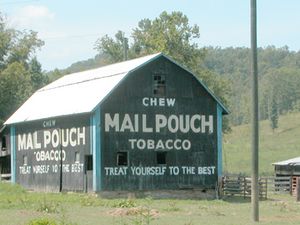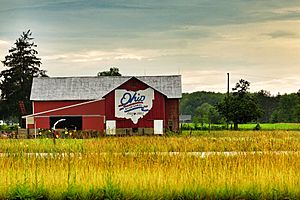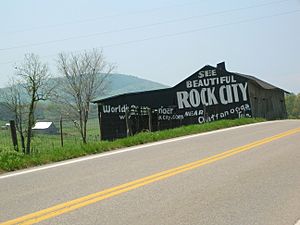Barn advertisement facts for kids


A barn advertisement is a large picture or message painted on the outside of a barn that people can see from the road. Companies paid barn owners to paint their logos and slogans on these buildings. This was a smart way to advertise because barns are often big and easy to spot in the countryside. People who painted these large outdoor ads were sometimes called "wall dogs."
Barn advertisements were very common in the Midwest and Southeast during the early to mid-1900s. They were like big billboards. Today, you don't see as many new ones. Many old barn ads are fading away, just like the barns themselves. They are sometimes called "ghost signs" because they are old and faint.
Contents
Who Used Barn Advertisements?
Many different businesses used barn ads. These included local places to visit, restaurants, and companies that made chewing tobacco.
Mail Pouch Barns
The Bloch Brothers Tobacco Company helped make barn advertising popular. They started painting ads on buildings in 1890. By 1925, they were painting their "Mail Pouch Tobacco" ads on barns. At its peak in the early 1960s, about 20,000 barns in 22 states had Mail Pouch ads. Most of these were in Ohio. A famous painter named Harley Warrick painted most of these barns. Other tobacco companies, like Red Man, also painted barns, but not as many.
Rock City Barns
In the early 1940s, a painter named Clark Byers painted barns and their roofs for Rock City. This was a popular place to visit near Chattanooga, Tennessee. His messages often told travelers they could see seven states from Lookout Mountain at Rock City. Byers painted ads for Rock City on over 900 barn roofs in 19 states!
Restaurant Ads on Barns
More recently, Bob Evans Restaurants painted barns in Indiana and Illinois. These ads looked just like their regular billboards. They stopped doing this in 2001. Later, the restaurant chain painted some barns with the colors of the Italian flag to advertise their pasta dishes. Frisch's Big Boy also used to advertise on barns.
Ohio Bicentennial Barns
From 1997 to 2002, the Ohio Bicentennial Committee hired Scott Hagan to paint 101 barns. He painted one barn in each county in Ohio. These barns had the committee's logo and colors. They celebrated Ohio's 200th anniversary in 2003.
Each barn took about 18 hours to paint and used about 7 gallons of paint. Many people traveled across Ohio to watch Hagan paint these special barns. It's thought that about one million people saw at least one of these barns.
Since 2009, Scott Hagan has also painted barns in West Virginia. These barns carry messages about staying away from tobacco products and raising breast cancer awareness.
Why Were Barn Ads Regulated?
In 1965, the U.S. government passed a law called the Highway Beautification Act. This law aimed to control and sometimes remove billboards along major highways. Barn advertisements were also affected by this law. Some barn owners painted over their ads because of it.
However, people really liked these barn ads. They saw them as part of the countryside's history. Because of this public support, the law was changed in 1974. This change specifically allowed barn ads to stay, calling them "folk heritage barns."
Another law, the National Historic Barn Preservation Act of 2001, helps protect barns that are 50 years or older. It also helps fund programs that teach people about these important structures.
How Were Barn Ads Painted?
Painters usually sketched the advertisements first. Then, they painted them by hand while standing on a special platform called a scaffolding. This allowed them to reach all parts of the barn.


